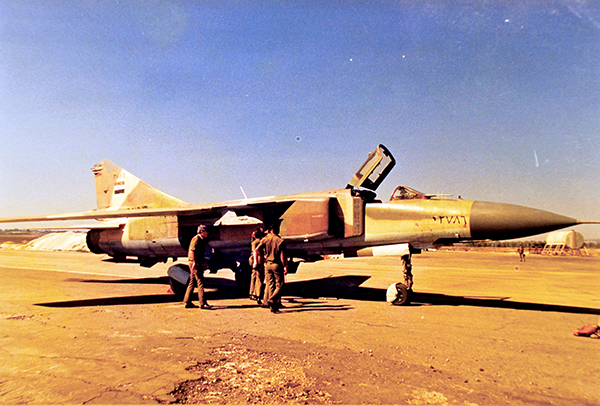While the IAF was pleased to acquire the MiG-23, they were pretty embarrassed that an enemy aircraft had crossed the boundary and landed without being challenged
The Israel Air Force (IAF) finally had the opportunity to conduct another thorough engineering examination of a front-line Arab fighter after a 23-year gap. Like the MiG-21, this MiG-23 was a defection, although one that caught Israel off guard. Major Adel Bassciii (also known as Basaam) of the Syrian Air Force flew his MiG-23MLD “Flogger-G” to Israel on October 11, 1989, and asked for political asylum. A two-ship training trip was led by Bassem, who was traveling in aircraft 2786.
The Major abruptly broke away and accelerated toward Israel while flying parallel to the Golan border. Despite IAF air defense radars following the Syrian plane, Bassem lowered to a height of 90–150 feet (25–45 meters), when radar tracking of his fighter was lost. He sped through the border at 550 kph while using the afterburner. He swiftly landed after spotting Megiddo’s northern airfield, which was at the time a civilian airport.
It took just seven minutes for the incident. Dissatisfaction with his position in Syria served as the driving force for Bassem’s activities. The Israel Air Force (IAF) was pleased to acquire the MiG, but they were a little ashamed that an enemy fighter had crossed the border and landed without being challenged, according to Bill Norton in his book Air War On The Edge: A History of the Israel Air Force and its Aircraft from 1947. The prize of the IAF was transferred to Tel Nof’s safety.
With the exception of a full load of cannon shells, the MiG-23 came unarmed. At the base of the tail, it had Syrian flare dispenser units mounted. Major Bassem assisted the IAF in starting its inspection but, regrettably, he only brought his checklist. On January 29, 1990, the aircraft ascended to the skies once more as the technicians, engineers, and test pilots of the IAF Flight Test Center finally felt secure enough to carry out the first of numerous evaluation flights. All future flights were conducted by Lieutenant Colonel Ofer Safra, the Flight Test Center’s commander and chief pilot.
The effectiveness of the aircraft and its technologies, as well as its vulnerabilities, were exposed through a comprehensive testing program. Drills in air combat against IAF front-line fighters were part of the trials. The MiG-23’s excessive thrust and acceleration pleased the Israelis. The avionics and jet were both simple to operate. Landings were a reasonably regular occurrence. On the downside, the cockpit layout required a lot of tweaking, and there was a poor rearward view and exhaustingly high stick forces during air combat maneuvers. A more sophisticated radar system separated the MiG from the F-4 Phantom in terms of overall performance.
Up until the early half of 1993, the IAF kept the MiG and flew it 12–18 times. Very likely, the Americans also had an opportunity to evaluate the machine. After that, it was lent to Israel Aircraft Industries (IAI) for use in creating prospective system upgrades. The upgraded products would subsequently be sold to Eastern Europe’s developing market. The MiG was moved to the IAF Museum in Hatzerim in the mid-1990s after IAI concluded working on it.

Above the Syrian roundels on the nose but outside of the roundels on the wings, the Israelis added their national markings. The finish and other markings were left untouched, with the exception of a few spots where paint needed to be touched up. The MANAT [# 109] and Unit 22 [# 123], the IAF’s Central Maintenance Unit, and stencils noting the IAF’s flights were placed on the jet when it was added to the collection of the IAF Museum.
Photo by Israeli Air Force and Oren Rozen via Wikipedia


